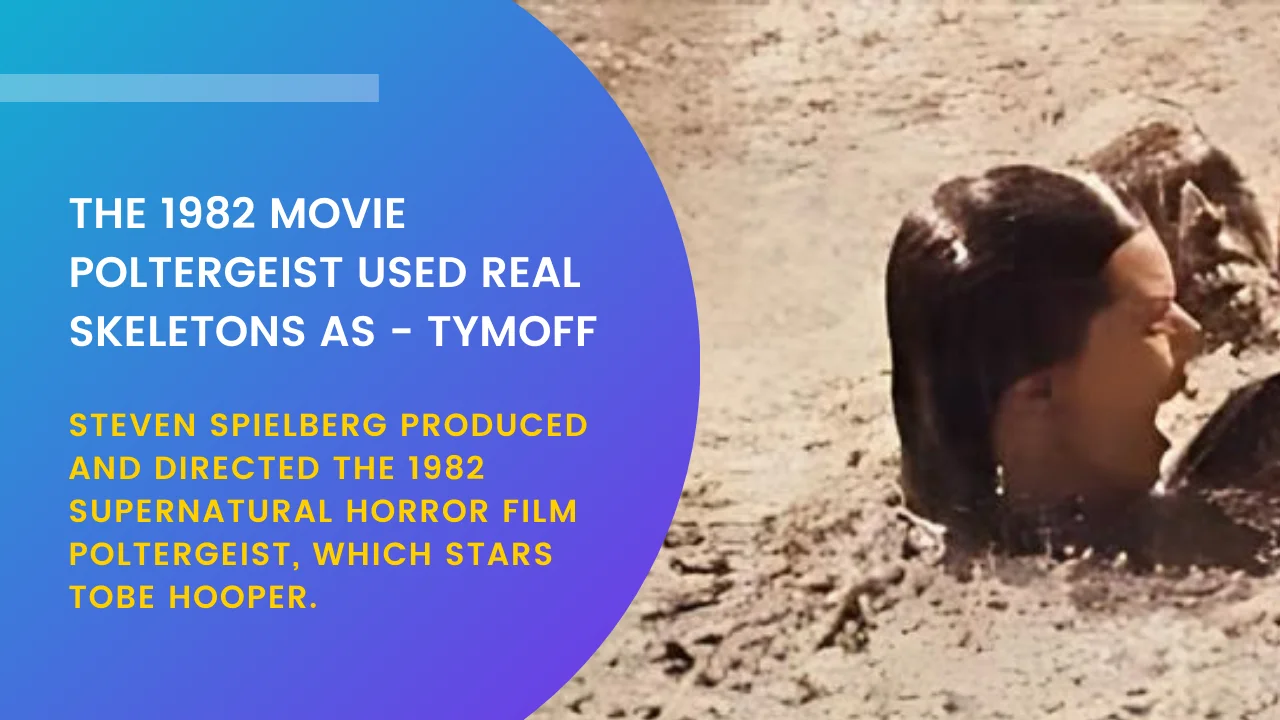Songwriter Ed Sheeran has done it again with ‘The unnerving discovery that actual human skeletons were utilized as props in the 1982 horror film Poltergeist added to the film’s enduring impact on the genre, joining the film’s eerie storyline and terrifying special effects. The 1982 Movie Poltergeist Used Real Skeletons As – Tymoff, highlighting a controversial decision motivated by cost and practicality concerns, has consequently generated extensive debate. Issues concerning the ethical consequences of such practices in the film industry have been heightened by this revelation. This article will delve into the history of the controversy, the rationale for using real skeletons, the effects on the crew and actors, and the larger implications for the ethics of filmmaking.
What is Poltergeist and Why is it Notable?
Steven Spielberg produced and directed the 1982 supernatural horror film Poltergeist, which stars Tobe Hooper. The film follows the Freeling family as they navigate the unsettling paranormal activity that takes place in their home. In this suspenseful and supernaturally horrifying film, viewers tag along as the family fights evil spirits.
Many consider Poltergeist a classic of the horror genre, and it became a commercial success very fast. Its innovative special effects were revolutionary for their time, and audiences were genuinely scared by it. Beyond its artistic merits, though, the film is linked to a string of disturbing and unfortunate occurrences that have collectively been dubbed the “Poltergeist curse.”
Timeline of Key Events Related to Poltergeist (1982)
I’ll create a simple timeline chart that outlines the major events associated with the Poltergeist movie, from its production to the aftermath and the evolution of its legacy.
Key Events Timeline
- 1981: Poltergeist production begins.
- 1982: Poltergeist is released, becoming a box office success.
- 1982: The use of real skeletons during the production is publicly disclosed.
- 1982 – 1988: Several cast members die under tragic or mysterious circumstances, leading to the “Poltergeist curse” narrative.
- 1990s: Public and industry debates on the ethics of using real human remains in films become more prominent.
- 2000s: Advancements in CGI and special effects reduce the need for real skeletons, leading to a shift in industry practices.
- Present Day: Poltergeist remains a cultural touchstone in the horror genre, with the real skeleton controversy still being a topic of discussion.
The Real Skeletons Controversy
The Decision to Use Real Skeletons
A notorious part of Poltergeist is the fact that actual human bones were utilized in its making. The primary motivation behind this choice was to provide viewers with a more authentic and terrifying experience. Since high-quality plastic skeletons were prohibitively expensive and hard to come by, using actual skeletons was seen as a practical and economical alternative. The creators of the film thought that using actual skeletons would give the scenes a more realistic feel and heighten the audience’s sense of horror.
The Source of the Skeletons
Poltergeist allegedly used actual human skeletons purchased from medical supply companies. It was standard practice for hospitals and other medical facilities to sell human remains to universities and other research organizations in the late 20th century. Selling these skeletons to museums, universities, and even movie sets, these objects originated in nations with laxer ethical standards. Despite its current contentiousness, the use of these skeletons in Poltergeist was in keeping with the times.
Impact on the Cast and Crew
Everyone involved with making Poltergeist was deeply affected by the revelation that actual human remains were utilized in the film. Playing Diane Freeling, actress JoBeth Williams said she didn’t find out about the use of actual skeletons until after filming had wrapped. Upon discovering the truth, she felt uneasy and uncomfortable, and she said she would have liked to have been told beforehand. This discovery further added to the film’s reputation for being associated with the “Poltergeist curse,” as many people think that the use of actual human remains could have played a role in the subsequent tragic events.
The Ethical Debate
Many people are worried about the moral consequences of using actual skeletons in a film like Poltergeist. Some people think it’s disrespectful to use people’s remains in a movie because it devalues the dead and their dignity. In their view, filmmakers should put ethical concerns ahead of practical ones, particularly when working with delicate subjects like human remains. Filmmakers are reevaluating their methods to make sure they are considerate and compassionate in light of the Poltergeist controversy, which has highlighted the significance of ethical standards in the industry.
The Legacy of Poltergeist and the Real Skeletons
The “Poltergeist Curse”
The iconic Poltergeist skeleton has become synonymous with the ill-fated “Poltergeist curse.” The unfortunate and premature deaths of several members of the film’s crew and cast are what this curse is alluding to. Some people think that these bad things happened because the use of human remains brought about supernatural forces or negative energy. The film’s association with actual skeletons has contributed to its infamous reputation and made it a legendary horror film, even though there is no scientific proof of a curse.
Cultural Impact and Public Perception
The public’s opinion of Poltergeist and its legacy are deeply affected by the controversy surrounding the film’s use of real skeletons. Real human remains were utilized in the film, which adds an additional level of horror and unease for many viewers. Because of this, audiences are now more conscious of the ethical considerations that go into making films, and as a result, they are scrutinizing the techniques used in horror films and other genres more closely. The legacy of the controversial horror film Poltergeist is still fascinating and hotly debated, but it hasn’t stopped its enduring popularity or impact.
Changes in Filmmaking Practices
The film industry’s ethics and practices have changed considerably since Poltergeist came out. Ethical standards in filmmaking, especially regarding the handling of human remains and other delicate materials, have come into sharp focus as a result of the controversy surrounding the use of actual skeletons. Filmmakers nowadays are less likely to use actual human remains and more likely to employ high-quality replicas and digital effects to achieve realistic scenes. As the film industry strives to strike a balance between artistic vision and ethical considerations, this shift reflects a larger trend towards more responsible and compassionate practices.
The Role of Special Effects in Modern Horror Films
One example of how crucial special effects are to making a terrifying movie is Poltergeist, which makes use of actual skeletons. The use of actual human remains was a contentious decision, but it demonstrated the extreme measures filmmakers will take to appear authentic and realistic. Since the release of Poltergeist, technological developments have revolutionized special effects, enabling filmmakers to craft more realistic and terrifying scenes without using unethical methods. Modern horror films are brought to life by special effects artists who employ a mix of practical effects, computer-generated imagery (CGI), and animatronics to terrify and entertain viewers.
Comparison of Real Skeletons vs. Artificial Skeletons in Filmmaking
| Aspect | Real Skeletons | Artificial Skeletons |
| Cost | Less expensive at the time of Poltergeist | More expensive, especially for high-quality replicas |
| Realism | Extremely realistic due to being genuine | Can be very realistic with modern technology, but less so in the 1980s |
| Ethical Considerations | Highly controversial; seen as disrespectful | Ethically sound and respectful of human dignity |
| Impact on Cast and Crew | Potential psychological impact; discomfort | No significant ethical or psychological concerns |
| Long-term Legacy | Associated with the “Poltergeist curse” and negative publicity | No associated curses or controversies, generally seen as standard practice |
| Availability | Readily available through medical suppliers | Limited availability at the time due to high costs and manufacturing complexity |
Also Read: Drawing:a4z_-ymtkr8= Cat
Conclusion
The controversial use of actual human skeletons as props in the 1982 horror film Poltergeist will go down in history alongside the film’s horrifying plot and innovative special effects. An ongoing debate has been sparked about the ethical implications of using human remains in film productions, driven by this decision that was driven by practicality and cost considerations. There is a strong connection between the film Poltergeist and the “Poltergeist curse,” a string of unfortunate occurrences that have contributed to the horror film’s reputation.
Lessons from Poltergeist highlight the significance of upholding ethical standards in filmmaking, which is crucial as the industry undergoes continuous change. The success of a horror film hinges on its realism and authenticity, but these factors should never compromise the respect and dignity of its characters. Filmmakers can now realize their artistic visions while staying true to their ethical principles thanks to modern special effects technology that allows them to create realistic and horrifying scenes without using actual human remains.
The legacy of the horror classic Poltergeist never ceases to enthrall and amaze viewers. Adding to the film’s mystique and guaranteeing its enduring memory is the controversy surrounding the use of real skeletons, which has become an essential aspect of its history.

Karen Altizer is a seasoned professional with a wealth of expertise in marketing and communications, adept at crafting compelling narratives and strategic messages tailored to various stakeholders.

